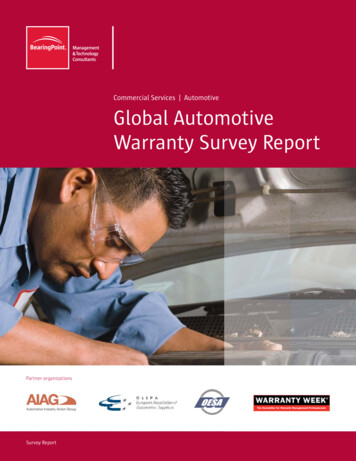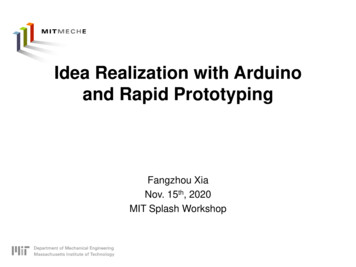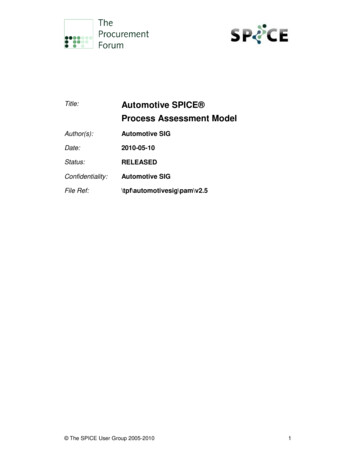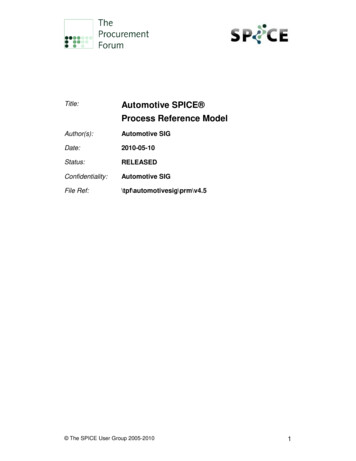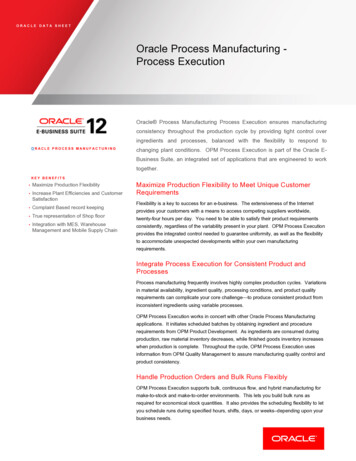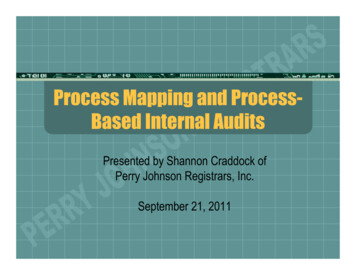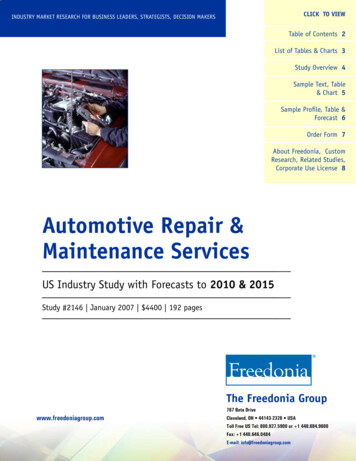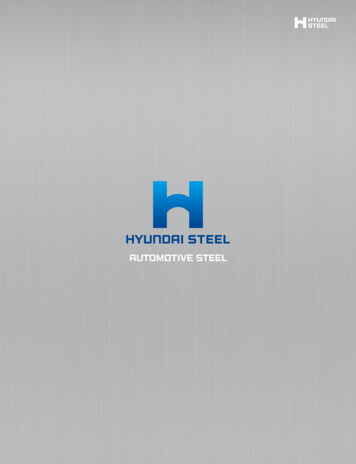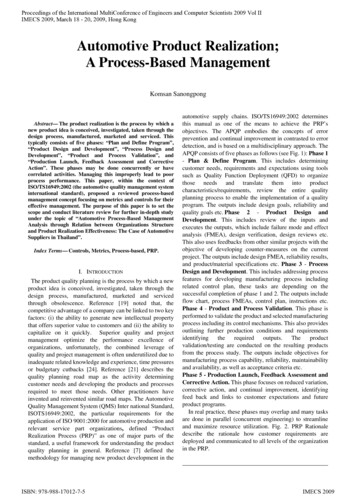
Transcription
Proceedings of the International MultiConference of Engineers and Computer Scientists 2009 Vol IIIMECS 2009, March 18 - 20, 2009, Hong KongAutomotive Product Realization;A Process-Based ManagementKomsan SanongpongAbstract— The product realization is the process by which anew product idea is conceived, investigated, taken through thedesign process, manufactured, marketed and serviced. Thistypically consists of five phases: “Plan and Define Program”,“Product Design and Development”, “Process Design andDevelopment”, “Product and Process Validation”, and“Production Launch, Feedback Assessment and CorrectiveAction”. These phases may be done concurrently or havecorrelated activities. Managing this improperly lead to poorprocess performance. This paper, within the context ofISO/TS16949:2002 (the automotive quality management systeminternational standard), proposed a reviewed process-basedmanagement concept focusing on metrics and controls for theireffective management. The purpose of this paper is to set thescope and conduct literature review for further in-depth studyunder the topic of “Automotive Process-Based ManagementAnalysis through Relation between Organizations Structureand Product Realization Effectiveness: The Case of AutomotiveSuppliers in Thailand”.Index Terms— Controls, Metrics, Process-based, PRP.I. INTRODUCTIONThe product quality planning is the process by which a newproduct idea is conceived, investigated, taken through thedesign process, manufactured, marketed and servicedthrough obsolescence. Reference [19] noted that, thecompetitive advantage of a company can be linked to two keyfactors: (i) the ability to generate new intellectual propertythat offers superior value to customers and (ii) the ability tocapitalize on it quickly. Superior quality and projectmanagement optimize the performance excellence oforganizations, unfortunately, the combined leverage ofquality and project management is often underutilized due toinadequate related knowledge and experience, time pressuresor budgetary cutbacks [24]. Reference [21] describes thequality planning road map as the activity determiningcustomer needs and developing the products and processesrequired to meet those needs. Other practitioners haveinvented and reinvented similar road maps. The AutomotiveQuality Management System (QMS) Inter national Standard,ISOTS16949:2002, the particular requirements for theapplication of ISO 9001:2000 for automotive production andrelevant service part organizations, defined “ProductRealization Process (PRP)” as one of major parts of thestandard, a useful framework for understanding the productquality planning in general. Reference [7] defined themethodology for managing new product development in theISBN: 978-988-17012-7-5automotive supply chains. ISO/TS16949:2002 determinesthis manual as one of the means to achieve the PRP’sobjectives. The APQP embodies the concepts of errorprevention and continual improvement in contrasted to errordetection, and is based on a multidisciplinary approach. TheAPQP consists of five phases as follows (see Fig. 1): Phase 1- Plan & Define Program. This includes determiningcustomer needs, requirements and expectations using toolssuch as Quality Function Deployment (QFD) to organizethose needs and translate them into productcharacteristics/requirements, review the entire qualityplanning process to enable the implementation of a qualityprogram. The outputs include design goals, reliability andquality goals etc. Phase 2 - Product Design andDevelopment. This includes review of the inputs andexecutes the outputs, which include failure mode and effectanalysis (FMEA), design verification, design reviews etc.This also uses feedbacks from other similar projects with theobjective of developing counter-measures on the currentproject. The outputs include design FMEA, reliability results,and product/material specifications etc. Phase 3 - ProcessDesign and Development. This includes addressing processfeatures for developing manufacturing process includingrelated control plan, these tasks are depending on thesuccessful completion of phase 1 and 2. The outputs includeflow chart, process FMEAs, control plan, instructions etc.Phase 4 - Product and Process Validation. This phase isperformed to validate the product and selected manufacturingprocess including its control mechanisms. This also providesoutlining further production conditions and ctvalidation/testing are conducted on the resulting productsfrom the process study. The outputs include objectives formanufacturing process capability, reliability, maintainabilityand availability, as well as acceptance criteria etc.Phase 5 - Production Launch, Feedback Assessment andCorrective Action. This phase focuses on reduced variation,corrective action, and continual improvement, identifyingfeed back and links to customer expectations and futureproduct programs.In real practice, these phases may overlap and many tasksare done in parallel (concurrent engineering) to streamlineand maximize resource utilization. Fig. 2. PRP Rationaledescribe the rationale how customer requirements aredeployed and communicated to all levels of the organizationin the PRP.IMECS 2009
Proceedings of the International MultiConference of Engineers and Computer Scientists 2009 Vol IIIMECS 2009, March 18 - 20, 2009, Hong Kongproductivity, and conformance quality [20]. Reference [11]proposed four basic types of metrics for PRP as follows;Customer requirementsManagementFMEAErrorProofingControl planOperator instructionsFig. 2. PRP RationaleFig. 1. APQP Phases (AIAG, 1995)The purpose of this paper is to set the scope and conductliterature review for further in-depth study under the topicof “Automotive Process-Based Management Analysisthrough Relation between Organizations Structure andProduct Realization Effectiveness: The Case ofAutomotive Suppliers in Thailand”.2. Managing the product realization process (PRP)In Thailand, the automotive industry’s methodologiesused to monitor the performance of the PRP are not suitablydefined which lead to poor performance of PRP. This paper,within the context of ISO/TS16949:2002 (the automotivequality management system international standard),proposed the process-based management strategies inmanaging the PRP focusing on metrics and controls. Thereare two rationales behind the strategies. First, the PRPperformance is measured to assure an adequate level ofperformance through establishment of appropriate metrics.Second, the PRP is controlled to help assure the desiredresults and lead to continual improvements.2.1 MetricsThe PRP performance is measured to assure an adequatelevel of performance through establishment of product,process and program performance metrics. These are neededto set goals and lead to controls and improvements. Propermetrics need to be selected. Improper metrics can optimizethe performance at the over expense of cost, requiresignificant effort to collect data and develop withoutproviding meaningful information of any real benefit.Criteria for effective metric typically include: simple,understandable, logical and repeatable. Some simple targetareas of successful product development efforts [33]included product cost, product quality, developmentcapability, development cost, and development time.ISO/TS16949:2002 defined the criteria as follows:measurable, consistent with organization goal, based onbusiness objectives and the business process, addresscustomer expectation, and achievable within a defined timeperiod. Selecting the suitable metrics is very crucial inmeasuring the PRP. Traditionally PRP competitivecapabilities have been measured on the basis of lead times,ISBN: 978-988-17012-7-5Process metrics - short-term metrics that measure theeffectiveness of the PRP and used to predict program andproduct performance e.g. cost of poor quality, unitproduction cost, and process capability etc., Product metrics- medium-term metrics that measure effectiveness in meetingproduct objectives/technical performance measures; GenericDesign - e.g. mean time between failure, Electrical Design e.g. number of design review changes/total terminations,Mechanical Design – e.g. number of in-process designchanges/number of parts, Software Engineering – e.g.man-hours/1,000 software lines of code etc., Programmetrics - medium-term metrics that measure effectiveness inexecuting the development program e.g. actual staffing(hours or headcount) vs. plan, personnel turnover rate, % ofmilestone dates met, and schedule performance etc.,Business metrics - longer term metrics that measure theeffectiveness of the enterprise in developing new productse.g. breakeven time or time-to-profitability etc. The metricsuccess factors can includes; management become moreaware of their quantitative information requirements, workcentre becomes process driven, metrics are integrated intodaily practice, measures are oriented to achieve objectives,processes are managed from the numbers, and managementuses the measure to improve capabilities. Most ofdevelopment programs failed because they are not focused onbusiness issues and do not have metrics that driveimprovements [9]. Reference [20] found that, using data froma large sample of PRP, the result support the claim thatsimultaneous pursuit of multiple competitive capabilitiesenhances PRP success. For example, time-to-market andconformance quality were directly and significantly related toall measures of PRP success. Also, the interactions ofconformance quality and cost, conformance quality andtime-to-market, and product cost and time-to-market werefound to influence different measures of PRP success.IMECS 2009
Proceedings of the International MultiConference of Engineers and Computer Scientists 2009 Vol IIIMECS 2009, March 18 - 20, 2009, Hong KongInput ofProcess AOutput ofProcess AProcess AManagementResponsibilityInput ofProcess BProcess BProcess CSub processesFig. 3 processes linkages2.2 Controls“ The management shall review the productrealization process and the support processes to assure theireffectiveness and efficiency [18] ” The PRP is subjected tobe controlled to help assure the desired results in terms ofboth effectiveness and efficiency. These controls are in theform of design reviews including verifications andvalidations as part of the review. The requirements of designand development review, verification and validations areidentified in the ISO/TS16949:2002 standard under the PRPpart. Design and development reviews focus on addressingthe technical requirements of the development program andthe business progressive requirements. In order to control thePRP through its review, verification and validation, it isnecessary to understand the process-based QMS. TheISO/TS16949:2002 standard applied the concept of “processapproach” to enhance customer satisfaction by meetingcustomer requirements. An activity using resources, andmanaged in order to enable the transformation of inputs intooutputs, can be considered as a process [17]. A process maycomprise of many sub-processes/activities depending on howwe identify the process. Often the output from one processdirectly forms the input to the next (see Fig. 3 processeslinkages). The application of a system of processes within anorganization, together with the identification and interactionsof these processes, and their management, can be referred toas the “process approach” [17]. An advantage of the processapproach is the ongoing control that provides over thelinkage between the individual processes within the systemof processes, as well as over their combination andinteraction.In real practice, especially in the nature of automotiveindustry, an organization can classify the processes exists inthe Quality Management System (QMS), including the PRPinto three categories; Customer Oriented Process (COP), the processes whoseoutput influence directly to the customer satisfaction.(Typically these processes are bid and tender, contractreview, design and development, manufacturing, anddelivery etc.) Support Process, the processes whose output support theCOPs and other support processes to function properly.(Typically these processes are training, purchasing, andmaintenance etc.)ISBN: 978-988-17012-7-5CUSResourceManagement, analysisTM a n a g e me n timprovementOMEProductRRealizationOutputS InputCOPCUSTOMERSSupport processFig. 4 QMS functioning (a) Management Process, the process of review andmonitoring to all COPs and support process to assure theirefficiency and effectiveness (typically this is done throughmanagement review and internal audit)Fig. 4. QMS functioning (a), describes how PRP interactswith customer and other processes in the QMS includingmanagement process. It also shows that PRP is comprise ofCOPs and support processes as describe above. Fig. 4 QMSfunctioning (b), simply focusing on management controllingover COP and support process in the organization. Fig. 5 isthe extended illustration of Fig. 4 focused on the PRP itself.It describes the components of PRP which is divided into 5phases from the beginning till the end of the developmentprocess as describes in the introduction of this paper. ThePRP can be classified as COP which includes manysub-processes inside. Fig. 5 also shows the example ofsupport processes e.g. purchasing, training and maintenanceetc. These support processes are to be controlled togetherwith the COP as well. Design reviews includingverifications and validations are formal reviews conductedduring the development program to assure that the metrics,requirements, concept, and product or process satisfies therequirements of that stage of development, the issues areunderstood, the risks are being managed, and there is a goodbusiness case for development. Typical design reviewsinclude: requirements review, concept/preliminary designreview, final design review, and a productionreadiness/launch review including program’s progressaccordi
manufacturing process capability, reliability, maintainability and availability, as well as acceptance criteria etc. Phase 5 - Production Launch, Feedback Assessment and Corrective Action. This phase focuses on reduced variation, corrective action, and continual improvement, identifying feed back and links to customer expectations and future product programs. In real practice, these phases may .

